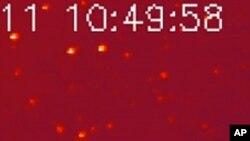Astronomers say a so-called "sungrazer" comet with the name Lovejoy that is due to pass the Earth on Thursday could shine so brightly it will be visible with the naked eye even in broad daylight.
The Lovejoy comet is expected to make an appearance in the Earth’s skies in the hours before it grazes the solar surface from a distance of only 140,000 kilometers at about midnight Friday UTC. Scientists say the streaking ball of ice and frozen gas likely will be completely destroyed in the intense heat of the Sun’s upper atmosphere, which is called the corona.
The Lovejoy comet is the first sungrazer in 40 years detected with a ground telescope. It is named for amateur astronomer Terry Lovejoy of Australia, who made the discovery only two-and-a-half weeks ago.
Scientists say Lovejoy's find is remarkable because usually comets like the one he discovered are detected by extremely advanced space-based telescopes, such as NASA’s orbiting STEREO probe.
Many astronomers say they are encouraged by the ground-based detection because it indicates that the Lovejoy comet could turn out to be one of only about 10 comets in the last 200 years bright enough to be viewed during the day by anyone looking skyward.
However, the highly respected science website, Space.com, strongly warns that no one should try to observe the Lovejoy comet when it is near the Sun, whether with the naked eye, or using binoculars and telescopes without the appropriate filters, because it could cause serious eye damage.
Sungrazing Lovejoy Comet Could Shine in Daylight Skies






